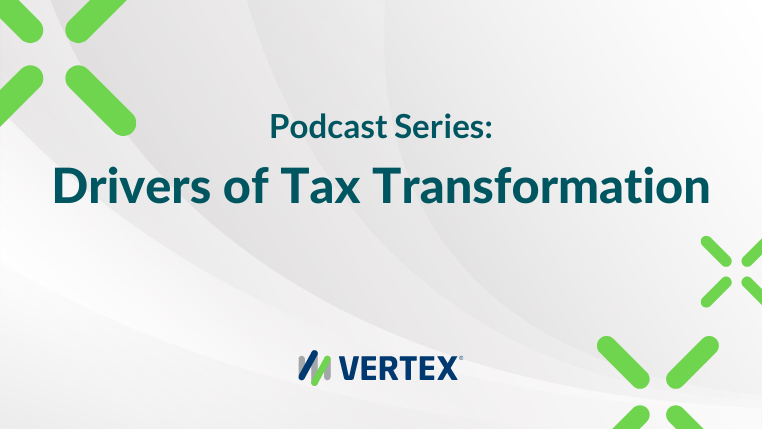Gunjan Tripathi: Welcome to Tax Matters, a Vertex podcast! I’m Gunjan Tripathi, Director of Solutions Marketing at Vertex.
In this episode, IDC Senior Research Director: European Enterprise Applications, Tom Seal, speaks with Business Writer, Eric Krell, about the drivers of tax transformation. They discuss how leading tax groups are progressing on their transformation journeys.
Tom starts by noting that businesses and tax leaders tend to define tax transformation broadly. Next, he discusses the factors driving the need for new strategies, processes, and tax technologies. Tom concludes by addressing improvement strategies, different types of tax technology, and the must-have features of an effective solution.
Now, I’ll turn it over to Eric and Tom…
Eric Krell: Thanks for joining me today, Tom. Let’s start with how tax transformation is defined and performed in Europe and the UK, and maybe even throughout the EMEA region. Does it generally tend to be defined narrowly or more comprehensively -- and any insights on how it should be viewed and performed?
Tom Seal: Well, I think it’s viewed quite comprehensively. I think organizations think very broadly about their tax affairs. And the European Union, if we think about the legislators, are also thinking very, very broadly here. Of course, the execution is a completely different kettle of fish, and organizations are having to think very carefully about how they execute the processes which relate to tax reporting. But, yes, in Europe, this is seen as a big, broad transformation, which is going to impact pretty substantially the way organizations do business and their relationship with the tax authorities.
Eric Krell: What are some of the most powerful factors driving the need for tax transformation?
Tom Seal: Well, it’s quite broad. Many organizations have pivoted toward e-commerce, particularly as a result of the pandemic. Organizations that maybe had almost no online presence, quite rapidly shifted to selling online. That in its own right creates a need for tax digitalization to at least some degree. But then what also happened is organizations that shifted online suddenly found that they were gaining customers in a whole array of jurisdictions. Suddenly someone would order something from another location, and there was a need to be able to handle that tax calculation and also deliver the numbers that were required to enable the person placing the order to know exactly how much they were going to pay and when they were going to be able to receive their orders. So, there was a customer experience side to this equation as well.
Eric Krell: What should they keep in mind about how they can affect and potentially improve the customer experience? What’s their role in that area?
Tom Seal: Well, I suppose the first thing for tax professionals, maybe the tax industry, to recognize is that customer experience is an incredibly sensitive area. If someone is looking to purchase something online and there’s even a little tiny barrier preventing them placing that order -- just that little bit of uncertainty -- it can be enough to lead to an order being unfulfilled, not being placed. Well, that’s a direct loss of revenue, or an opportunity loss. Instant data is absolutely critical there, and that’s the expectation of customers in the digital age. They will look elsewhere, or they will do nothing if they can’t get the information they need to make that purchase decision.
Eric Krell: Tax policy changes also pose major challenges to tax groups and businesses, especially for global companies that operate in multiple tax jurisdictions. What notable regulatory changes are keeping the head of tax and even the CFO awake at night?
Tom Seal: Well, I think there’s one major change that’s been boiling away in Europe for a few years now and will continue to evolve, and that’s a shift towards e-invoicing. That’s the big deal in Europe at the moment. It’s not entirely new. E-invoicing has been mandated in certain locations in Europe for several years now, particularly when it comes to selling to governments, so that’s well-established process and well-established way of working in some parts of Europe. But what is happening over the coming years is that e-invoicing is being mandated for all business transactions, so all B2B transactions need to be invoiced electronically. And that’s a major deal.
Eric Krell: Let’s get into e-invoicing. At a very high level, what are some of the challenges it poses to tax groups?
Tom Seal: Well, I suppose one of the challenges is awareness. It’s difficult for many organizations to understand and learn about what exactly the requirements are, particularly if they’re operating across multiple jurisdictions. There are a lot of lessons to be learned there, a lot of information required, and I think there’s a tendency for organizations to be slow in learning about the implications that these types of regulations are going to have on them. That’s the first thing. The second thing is that there is a technological implication. Many of the organizations that will be impacted by e-invoicing are not using financial applications at all at the moment. Many organizations that currently utilize spreadsheets, or possibly even paper, in the ways they run their accounting are suddenly going to have to submit e-invoices. There’s a massive leap for those organizations. There’s going to be a surge of interest in accounting platforms and particularly accounting platforms that can handle e-invoices.
Eric Krell: Tom, from a tax technology perspective, what should tax groups know about their improvement strategies and options?
Tom Seal: I think it’s important that the tax professional speak to their IT colleagues, collaborate with them and really start to understand what the options are, short-term and long-term. What we see in the way enterprises go about modernizing their technology architecture and the applications they use is that they want to go step by step. As we were saying, when it comes to tax as a whole, it’s really important to think long-term, think about how things might evolve and where an application or a piece of data may sit in the future.
Eric Krell: What about the build versus buy consideration? What are some areas that tax groups should look at when they’re weighing between those two options?
Tom Seal: I think it comes back to that core vs. non-core decision. And I’m sure there are some organizations that feel that there is some differentiation or advantage to building some tax functionality in-house. I’m trying to think right now what those reasons might be – it could possibly have something to do with business models in e-commerce. There may be organizations out there that feel they have a justifiable reason to develop some technology on their own. Maybe that they use a platform which is so unique that they feel something in-house is the way to go. But I think for the vast majority of organizations, they’re going to want to buy a tax engine.
Eric Krell: Let’s say a tax group is ready to invest in a tax engine: start by telling me three functionalities and capabilities they should look for in that type of solution.
Tom Seal: Well, I think some important functionality that they should consider includes the classification of items, of products, and services. One of the difficulties, especially in Europe, is the fact that it’s not just a question of what level of tax you apply -- be that VAT, GST or other indirect taxes -- it’s the actual scenarios in which you apply those taxes is quite complex. It depends on who you are, who you’re selling to and what the item is. I think the ability to address e-invoicing is probably also very important. And maybe lastly, is just reflecting on the fact that information, data, and insights are so critical to the modern finance function, so reporting capabilities will be very important as well. It’s hard to predict where that might lead, but I can well imagine that the data flowing back from a tax engine could drive decision-making; it might lead you to operating a business in a slightly different way, maybe even selling different products
Eric Krell: Tom, it’s been enjoyable and highly informative speaking with you today. Before we go, I want to ask one more question. When you’re looking ahead to the future of tax technology, what development or developments most excite you?
Tom Seal: Well, I think the revolution will be the fact that tax becomes essentially real-time. We’re really moving into a world where everything is instantaneous, and that includes tax. E-invoicing means that the tax authorities will see transactions as they happen, and I think that will be extremely interesting, and well. It will enable all sorts of innovations we probably haven’t even thought about. I’m hearing discussions now about dynamic pricing, so really potentially selling things for different prices at different times of the day in retail and so on. Obviously, every time that happens, it requires a tax calculation. It's hard to predict where things might lead, but I think probably the big shift is this move toward real-time, in-the-moment tax calculations and reporting.
Eric Krell: Thanks again, Tom.
Tom Seal: Thank you.
Gunjan Tripathi: Thanks for listening to Tax Matters and our series on tax transformation.
This transcript has been edited for clarity.


